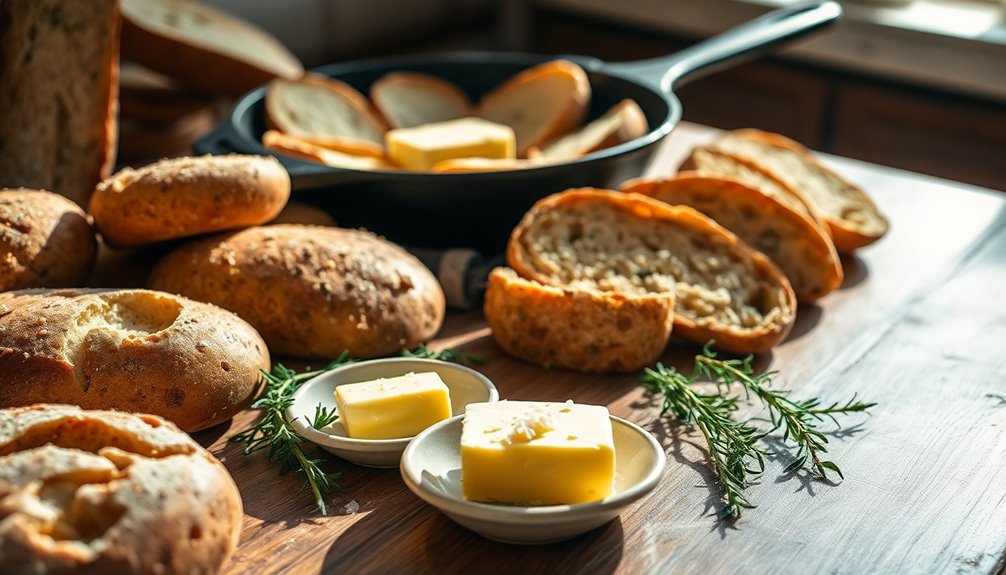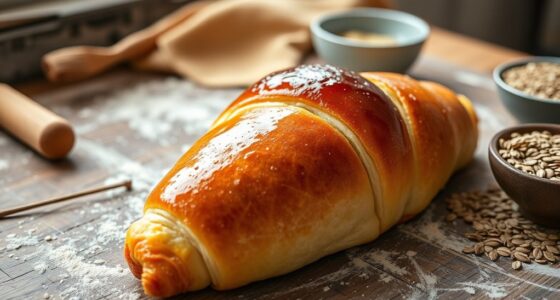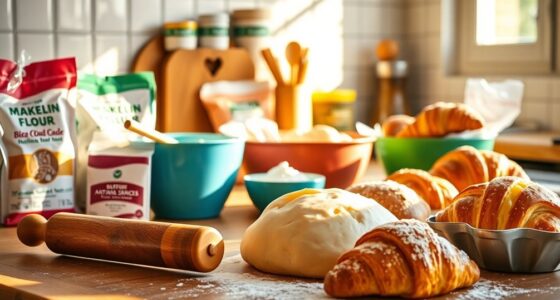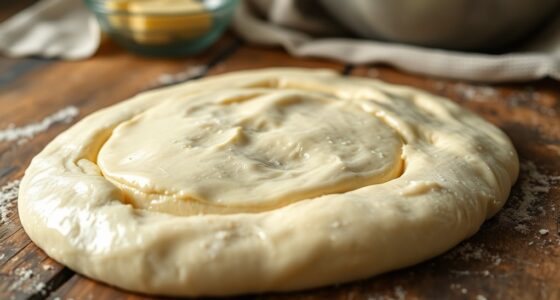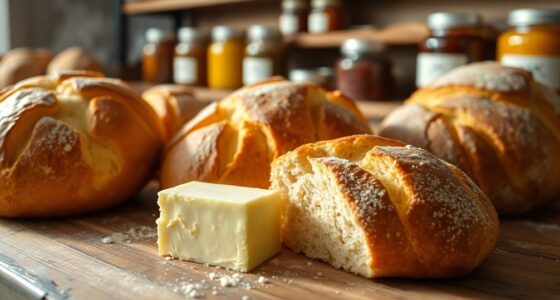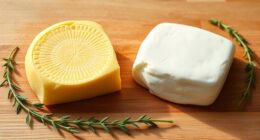Reviving stale bread is simple and fun! Start by preheating your oven and generously coat the bread with melted butter for moisture. Sprinkle garlic powder or your favorite spices to amp up the flavor. You can also experiment with flavored butters, like herb-infused or sweet honey spreads, for a unique twist. Bake until bubbly and golden, and enjoy warm with soups or salads. There's so much more you can do to elevate your stale bread experience!
Key Takeaways
- Preheat the oven to 375°F to ensure a crispy crust and moist interior when reviving stale bread.
- Generously coat stale bread with melted butter to enhance moisture and flavor before baking.
- Sprinkle garlic powder or your favorite herbs on warm bread to elevate its flavor profile.
- Experiment with flavored butters, such as herb-infused or sweet varieties, to complement the revived bread.
- Serve revived bread warm with toppings, enhancing meals alongside soups, salads, or on a charcuterie board.
History
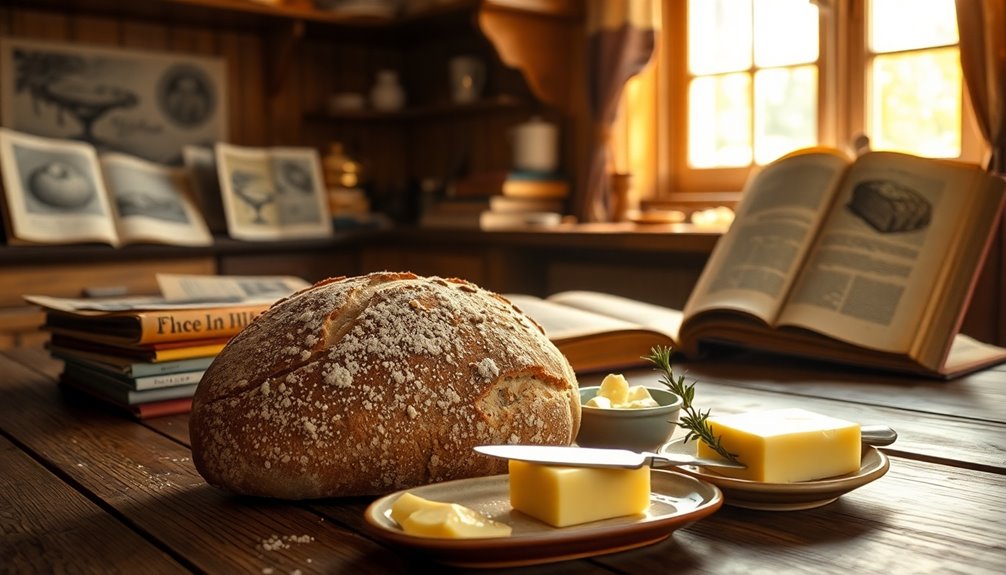
Since ancient times, people have found creative ways to revive stale bread, turning a simple necessity into a culinary tradition.
The history of reviving stale bread reflects a resourceful spirit, especially in ancient civilizations where food preservation was key for survival. In medieval Europe, households transformed stale bread into porridge or bread soups, making it an essential way to reduce food waste.
The French embrace this practice with "pain rassis," showcasing a culinary culture that celebrates leftovers through dishes like crostini and French toast.
During the Great Depression, families further adapted to limited resources by revitalizing stale bread, maximizing nutrition.
Today, chefs and home cooks continue this legacy, inventing new techniques and recipes, ensuring stale bread remains a valued ingredient.
Recipe

Reviving stale bread can transform it from a forgotten pantry item into a delightful accompaniment to your meals.
Whether you prefer a savory or sweet flavor, this recipe will guide you through creating delicious flavored butters that will breathe new life into your bread. With just a few simple ingredients, you can elevate your revived bread experience and impress your family and friends.
To begin, you'll need to gather your ingredients to make the flavored butter of your choice. Whether you opt for a garlicky herb butter, a sweet honey spread, or a cheesy compound butter, the right combination will ensure your stale bread becomes a gourmet treat.
After reviving the bread using your preferred method—whether it be baking, steaming, or microwaving—this flavored butter will melt beautifully into each warm slice, enhancing the taste and texture. Interestingly, butter has a long history of culinary traditions that showcase its versatility and importance in enhancing flavors.
Ingredients:
- Softened butter (1 cup)
- Minced garlic (2 cloves, for savory butter)
- Fresh herbs (1/4 cup parsley or chives, for savory butter)
- Pinch of salt (for savory butter)
- Honey or maple syrup (1/4 cup, for sweet butter)
- Ground cinnamon (1 teaspoon, for sweet butter)
- Grated cheese (1/2 cup Parmesan or feta, for compound butter)
To prepare your flavored butter, choose your desired flavor profile and combine the softened butter with the corresponding ingredients in a mixing bowl.
For the savory option, mix in the minced garlic, fresh herbs, and a pinch of salt. For the sweet variation, blend in honey or maple syrup along with a sprinkle of cinnamon. If you're making a compound butter, fold in the grated cheese.
Once well combined, transfer the mixture to a piece of parchment paper, shape it into a log, and refrigerate until firm. After reviving your stale bread, spread a generous layer of the flavored butter on each slice while it's still warm, allowing it to melt in for maximum flavor.
When reviving stale bread, it's essential to monitor the temperature and time carefully to prevent it from drying out further.
You can experiment with various flavor combinations by adding spices or other ingredients to your butter. Additionally, try serving the revived bread with your flavored butters on a charcuterie board, alongside soups, or as part of a salad for a gourmet touch.
Enjoy your delicious creation!
Cooking Steps
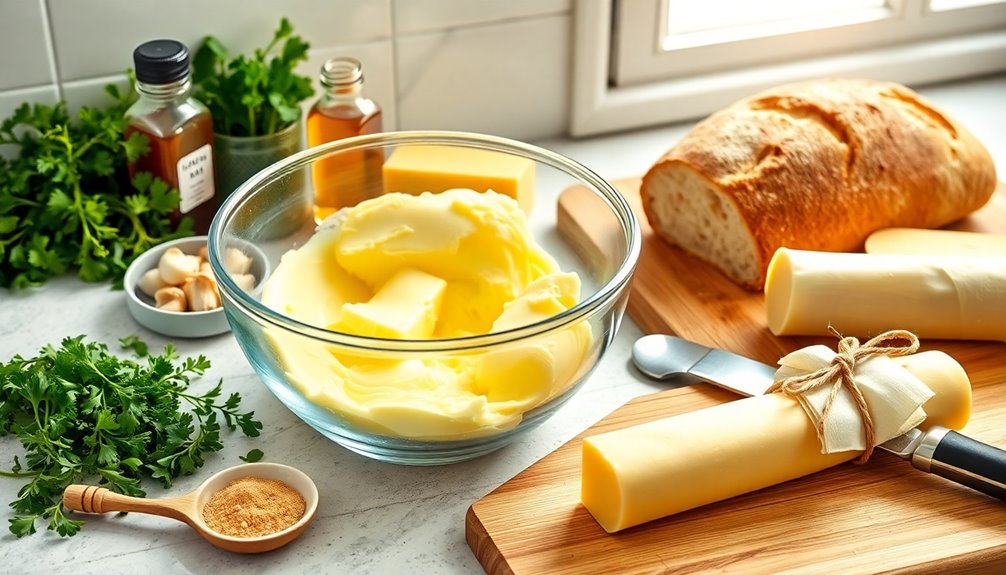
To bring your stale bread back to life, start by preheating your oven to 375°F.
Brush the bread with melted butter and sprinkle it with garlic powder for added flavor.
Don't forget to add your favorite toppings and cheese before baking to create a delicious treat! Additionally, using butter provides essential fatty acids and fat-soluble vitamins that can enhance the nutritional value of your meal.
Step 1. Preheat to 375°F

Preheating your oven to 375°F is essential for effectively reviving stale bread. This temperature creates the perfect environment for achieving a crispy crust while rehydrating the interior.
As you preheat, make sure to avoid overcrowding the oven with other items, as this can disrupt the heat circulation needed for optimal results.
Once the oven reaches 375°F, place the stale bread directly on the oven rack or on a sheet pan, allowing steam to circulate around it.
Keep a close eye on the bread, as baking time may vary based on its density and dryness, typically taking around 10 minutes.
With this method, you'll enjoy fresh, revitalized bread in no time!
Step 2. Brush With Melted Butter
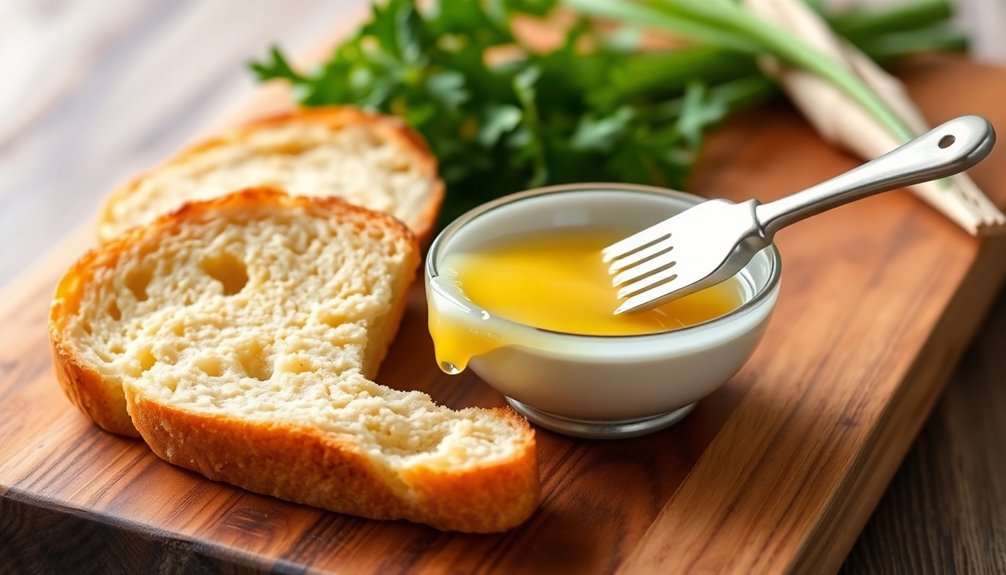
Once you've got your oven ready, melting some butter is the next step to bring stale bread back to life.
Start by melting your butter in a small saucepan or microwave until it's fully liquefied for easy application. Grab a brush or a spoon and generously coat the surface of the stale bread with the melted butter, ensuring it soaks in for added moisture and flavor.
If you want to elevate the taste, feel free to add herbs or spices to the melted butter before brushing it on. Herb-infused butter variations can transform the flavor profile of your bread, making it an even more delightful treat.
Place the buttered bread on a baking sheet and toast it in the oven at 350°F for about 8-10 minutes, or until the edges are golden and crispy.
Enjoy your revitalized bread warm!
Step 3. Sprinkle With Garlic Powder
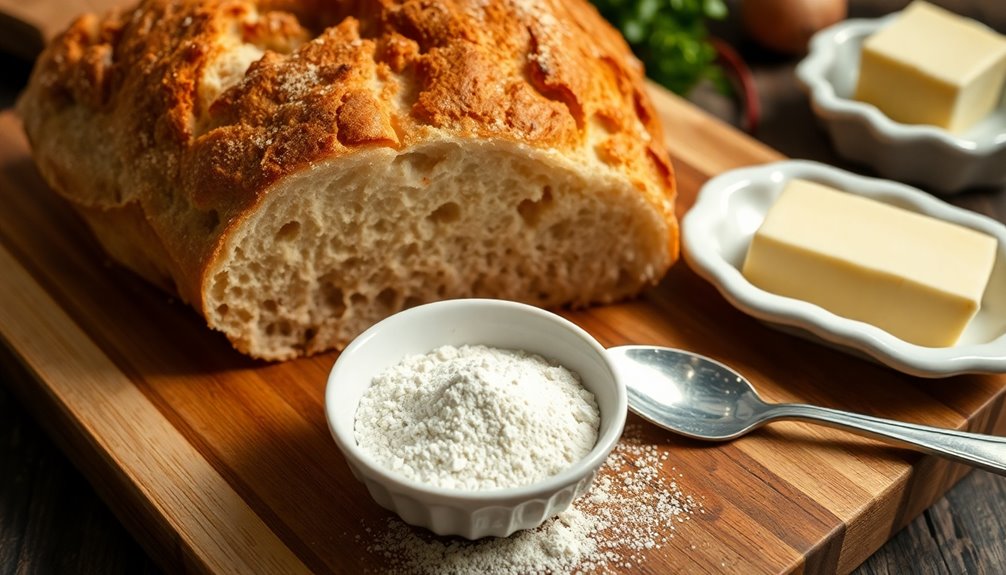
Reviving stale bread can be as simple as sprinkling it with garlic powder to add a burst of flavor.
Start by dampening the bread with a little water and wrapping it in aluminum foil. Bake it in the oven to restore its freshness and texture.
Once it's warmed up, slice the bread if you prefer, or keep it whole. While it's still hot, sprinkle garlic powder evenly over the surface, letting the heat release the garlic's delightful aroma.
For an even richer taste, drizzle melted butter over the garlic powder before serving. This garlic buttered bread makes a delicious side to soups, salads, or pasta dishes, elevating any meal effortlessly. Additionally, using color accuracy when choosing your bread presentation can enhance the overall dining experience.
Enjoy the enhanced flavors!
Step 4. Add Toppings Before Baking
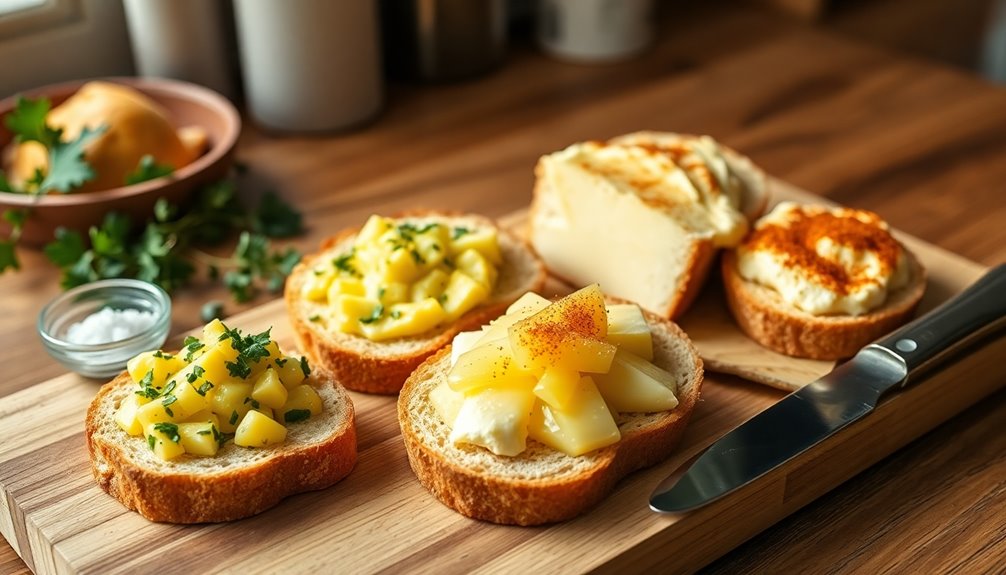
After you've sprinkled garlic powder on your warm bread, you can take it a step further by adding toppings before baking.
Start by generously spreading softened butter on your slices to enhance moisture and flavor. For a savory twist, consider minced garlic, fresh herbs, or even crushed red pepper flakes sprinkled on top of the buttered bread.
If you're in the mood for something sweet, a sprinkle of cinnamon and sugar or a layer of fruit preserves can refresh your stale bread into a delightful dessert.
Make sure to distribute the toppings evenly to achieve a delicious crust while baking.
Keep an eye on the oven, as baking usually takes around 10-15 minutes at 300°F, until your toppings are golden and crispy.
Step 5. Add Cheese Before Baking
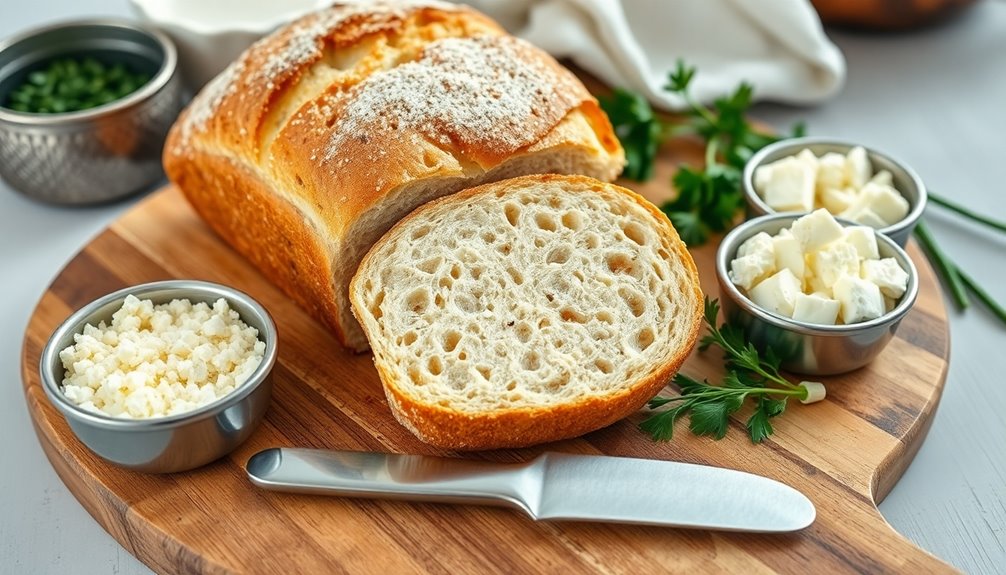
A great way to elevate stale bread is by adding cheese before baking.
Start by slicing your stale loaf open and spreading a generous layer of butter on each side. This'll enhance the flavor and moisture you need.
Next, top the buttered bread with your choice of cheese—mozzarella or cheddar works wonders. For an extra flavor boost, sprinkle some herbs, garlic powder, or spices over the cheese. Drizzle a little olive oil for added richness if you like.
Place your prepared bread on a baking sheet, then bake at 300°F for about 10-15 minutes, until the cheese is bubbly and the bread is crisp.
This transforms your stale loaf into a delicious, savory treat perfect as an appetizer or side dish. Additionally, combining this dish with a cup of French press coffee can enhance your overall dining experience.
Final Thoughts
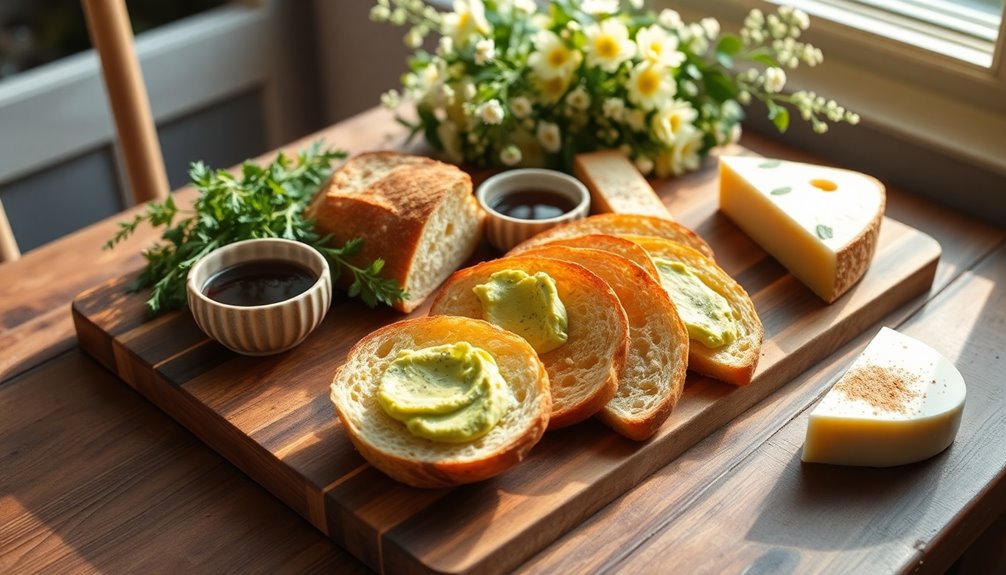
While many might overlook stale bread as unworthy, bringing it back to life not only enhances its flavor and texture but also reduces food waste.
Reviving stale bread can transform it into something delightful, with a moist interior and a crispy crust perfect for butter toppings. You can easily dampen the bread and bake it, restoring its former glory.
Experimenting with various butter toppings, like herb-infused or compound butters, can elevate your rejuvenated bread even further. Don't forget to spread some butter before toasting; it adds richness and enhances the overall experience.
Frequently Asked Questions
How Do You Bring Stale Bread Back to Life?
Like a phoenix rising from the ashes, you can bring stale bread back to life.
Start by moistening the crust under running water, then wrap it in aluminum foil and bake at 300°F for 15 minutes.
For a quick fix, try microwaving it wrapped in a damp paper towel for 10 seconds before giving it a crispy finish in a toaster oven.
How to Refresh Day Old Artisan Bread?
To refresh day-old artisan bread, start by running the crust briefly under water. This adds moisture so the interior can absorb steam while you bake it.
Preheat your oven to 300°F, then wrap the damp bread in aluminum foil to trap the steam for about 15 minutes.
If you want a crispy crust, unwrap it and bake for an additional 5 minutes.
Enjoy your revitalized bread with your favorite spreads!
Is There a Way to Make Hard Bread Soft Again?
Yes, you can definitely make hard bread soft again!
Start by running the crust under water to add moisture.
Then, wrap the damp bread in aluminum foil and heat it in a 300°F oven for about 15 minutes.
If you're in a hurry, microwave it wrapped in a damp paper towel for 10 seconds and then toast it.
Just be careful not to soak it too much, or it'll get soggy!
Can You Make Bread Crusty Again?
Imagine a baker's oven, the warm air filling the room with nostalgia.
You can definitely make bread crusty again! Just run the crust under water for a moment, then bake it at 300°F for 6 to 10 minutes.
For an extra boost, wrap it in aluminum foil to trap the steam, then crisp it up without the foil.
This simple process can bring back that delightful crunch you crave, transforming old bread into something fresh again.
